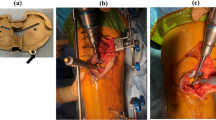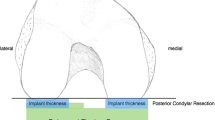Abstract
Purpose
The purpose of this prospective study was to compare femoral component rotation (FCR) values when adjusted with ‘gap balancing’ (GB) and ‘measured resection’ (MR) techniques following total knee arthroplasty (TKA). The study hypothesis was that the GB technique would be better on FCR than MR in TKA.
Methods
From a total of 93 unilateral TKAs performed between August 2019 and November 2020, the FCR values were adjusted by GB in 46 cases and MR in 47. Post-TKA magnetic resonance imaging (MRI) was applied for FCR assessment. Orthoroentgenograms and lateral knee radiographs were taken to determine the mechanical axis and posterior condylar offset (PCO) ratio, respectively. Both groups were compared radiologically. The Western Ontario and Mcmaster Universities Osteoarthritis Index (WOMAC), Knee Society Score (KSS), and Hospital for Special Surgery (HSS) patella scores were calculated and compared between the groups preoperatively and at the end of 6 months, and 1 and 2 years postoperatively.
Results
There was no difference between the groups in respect of the demographic data. The mean HSS patella score was 86.4 ± 4.1 in the GB group and 84.6 ± 3.8 in the MR group in the 2nd year (p = 0.047). A higher degree of external rotation in the FC was determined in the GB group [2.2° (1.7°–4.3°)] compared to the MR group [1.7° (0.8°–3.0°)] (p = 0.009). The postoperative increase in PCO ratio was higher in the GB group (p = 0.005). All other variables were similar in both groups.
Conclusion
The results of this study showed that at the end of the 2nd year, the HSS patella scores were better, FCs were more externally rotated and PCO ratios were higher in TKAs using the GB technique. However, taking into account that the difference between the 2nd year HSS patella scores was too small to be considered clinically significant, it was shown that both the GB and MR techniques can be used for FCR in clinical practice without any hesitation.




Similar content being viewed by others
Abbreviations
- FC:
-
Femoral component
- GB:
-
Gap balancing
- MR:
-
Measured resection
- TKA:
-
Total knee arthroplasty
- PCO:
-
Posterior condylar offset
- WOMAC:
-
Western Ontario and McMaster Universities Osteoarthritis Index
- KSS:
-
Knee Society Score
- HSS:
-
Hospital for Special Surgery
- MCL:
-
Medial collateral ligament
- MRI:
-
Magnetic resonance imaging
- MAVRIC:
-
Multi-Acquisition Variable Resonance Image Combination
- PCA:
-
Posterior condylar angle
- sTEA:
-
Surgical transepicondylar axis
- ROM:
-
Range of motion
- CR:
-
Cruciate retaining
- PS:
-
Posterior stabilized
References
Akagi M, Matsusue Y, Mata T, Asada Y, Horiguchi M, Iida H, Nakamura T (1999) Effect of rotational alignment on patellar tracking in total knee arthroplasty. Clin Orthop Relat Res. https://doi.org/10.1097/00003086-199909000-00019
Babazadeh S, Dowsey MM, Stoney JD, Choong PFM (2014) Gap balancing sacrifices joint-line maintenance to improve gap symmetry: a randomized controlled trial comparing gap balancing and measured resection. J Arthroplasty 29(5):950–954
Babazadeh S, Dowsey MM, Vasimalla MG, Stoney JD, Choong PFM (2019) Knee arthroplasty component malrotation does not affect function or quality of life in the short to medium term. J Arthroplasty 34(7):1382–1386
Baldini A, Anderson JA, Zampetti P, Pavlov H, Sculco TP (2006) A new patellofemoral scoring system for total knee arthroplasty. Clin Orthop Relat Res 452:150–154
Bellemans J, Banks S, Victor J, Vandenneucker H, Moemans A (2002) Fluoroscopic analysis of the kinematics of deep flexion in total knee arthroplasty. Influence of posterior condylar offset. J Bone Jt Surg Br 84(1):50–53
Bercovy M, Kerboull L, Müller JH, Saffarini M, Sailhan F (2022) Satisfactory mid- to long-term outcomes of TKA aligned using conventional instrumentation for flexion gap balancing with minimal soft tissue release. Knee Surg Sports Traumatol Arthrosc 30(2):627–637
Bourne RB, Chesworth BM, Davis AM, Mahomed NN, Charron KDJ (2010) Patient satisfaction after total knee arthroplasty: who is satisfied and who is not? Clin Orthop Relat Res 468(1):57–63
Chang MJ, Kang S-B, Chang CB, Han DH, Park HJ, Hwang K, Park J, Hwang I-U, Lee SA, Oh S (2020) Posterior condylar offset changes and its effect on clinical outcomes after posterior-substituting, fixed-bearing total knee arthroplasty: anterior versus posterior referencing. Knee Surg Relat Res 32(1):10
Cidambi KR, Robertson N, Borges C, Nassif NA, Barnett SL (2018) Intraoperative comparison of measured resection and gap balancing using a force sensor: a prospective, randomized controlled trial. J Arthroplasty 33(7S):S126–S130
Clement ND, Makaram N, Bell J, Tiemessen CH, Mehdi SA, Livingston SJ (2017) Columbus® computer navigated total knee arthroplasty: gap balancing versus measured resection. Knee 24(6):1442–1447
Dennis DA, Komistek RD, Kim RH, Sharma A (2010) Gap balancing versus measured resection technique for total knee arthroplasty. Clin Orthop Relat Res 468(1):102–107
Fan XY, Ma JH, Wu X, Xu X, Shi L, Li T, Wang P, Li C, Li Z, Zhang QY, Sun W (2021) How much improvement can satisfy patients? Exploring patients’ satisfaction 3 years after total knee arthroplasty. J Orthop Surg Res 16(1):389
Fehring TK (2000) Rotational malalignment of the femoral component in total knee arthroplasty. Clin Orthop Relat Res. https://doi.org/10.1097/00003086-200011000-00010
Gao Y-H, Li S-Q, Yang C, Liu J-G, Dong N, Qi X (2016) Favorable femoral component rotation achieved in severe varus deformity by using the gap-balancing technique. Knee 23(5):867–870
Goutham GDV, Jain VK, Sinha S, Arya RK (2020) Effect of posterior condylar offset in post operative range of motion in cruciate retaining and sacrificing TKR: a comparative analysis. J Orthop 20:342–346
Graw BP, Harris AH, Tripuraneni KR, Giori NJ (2010) Rotational references for total knee arthroplasty tibial components change with level of resection. Clin Orthop Relat Res 468(10):2734–2738
Hao K, Wei M, Ji G, Jia Y, Wang F (2022) Comparison of the imaging and clinical outcomes among the measured resection, gap balancing, and hybrid techniques in primary total knee arthroplasty. Orthop Surg. https://doi.org/10.1111/os.13525
Heesterbeek PJC, Jacobs WCH, Wymenga AB (2009) Effects of the balanced gap technique on femoral component rotation in TKA. Clin Orthop Relat Res 467(4):1015–1022
Hirschmann MT, Moser LB, Amsler F, Behrend H, Leclerq V, Hess S (2019) Functional knee phenotypes: a novel classification for phenotyping the coronal lower limb alignment based on the native alignment in young non-osteoarthritic patients. Knee Surg Sports Traumatol Arthrosc 27(5):1394–1402
Huang T, Long Y, George D, Wang W (2017) Meta-analysis of gap balancing versus measured resection techniques in total knee arthroplasty. Bone Jt J 99-B(2):151–158
Ishii Y, Noguchi H, Takeda M, Sato J, Toyabe S (2013) Posterior condylar offset does not correlate with knee flexion after TKA. Clin Orthop Relat Res 471(9):2995–3001
Jenny J-Y, Baldairon F, Hirschmann MT (2022) Functional knee phenotypes of OA patients undergoing total knee arthroplasty are significantly more varus or valgus than in a non-OA control group. Knee Surg Sports Traumatol Arthrosc 30(8):2609–2616
Johal P, Hassaballa MA, Eldridge JD, Porteous AJ (2012) The posterior condylar offset ratio. Knee 19(6):843–845
Keblish PA, Varma AK, Greenwald AS (1994) Patellar resurfacing or retention in total knee arthroplasty. A prospective study of patients with bilateral replacements. J Bone Jt Surg Br 76(6):930–937
Kim C-W, Lee C-R, Gwak H-C, Kim J-H, Kwon Y-U, Kim D-Y (2020) The effects of surgical technique in total knee arthroplasty for varus osteoarthritic knee on the rotational alignment of femoral component: gap balancing technique versus measured resection technique. J Knee Surg 33(02):144–151
Kim JI, Chun SH, Han HS, Lee S, Lee MC (2017) Femoral component rotations in different gap tensions in total knee arthroplasty: a prospective randomized controlled trial. Knee 24(2):439–446
Kinzel V, Ledger M, Shakespeare D (2005) Can the epicondylar axis be defined accurately in total knee arthroplasty? Knee 12(4):293–296
Kono K, Inui H, Tomita T, Yamazaki T, Taketomi S, Yamagami R, Kawaguchi K, Tanaka S (2022) The higher patient-reported outcome measure group had smaller external rotation of the femur in bicruciate-stabilized total knee arthroplasty. Knee Surg Sports Traumatol Arthrosc 30(4):1292–1299
Lee S-Y, Lim H-C, Jang K-M, Bae J-H (2017) What factors are associated with femoral component internal rotation in TKA using the gap balancing technique? Clin Orthop Relat Res 475(8):1999–2010
Li S, Luo X, Wang P, Sun H, Wang K, Sun X (2018) Clinical outcomes of gap balancing vs measured resection in total knee arthroplasty: a systematic review and meta-analysis involving 2259 subjects. J Arthroplasty 33(8):2684–2693
Malviya A, Lingard EA, Weir DJ, Deehan DJ (2009) Predicting range of movement after knee replacement: the importance of posterior condylar offset and tibial slope. Knee Surg Sports Traumatol Arthrosc 17(5):491–498
Migliorini F, Eschweiler J, Mansy YE, Quack V, Schenker H, Tingart M, Driessen A (2020) Gap balancing versus measured resection for primary total knee arthroplasty: a meta-analysis study. Arch Orthop Trauma Surg 140(9):1245–1253
Moorthy V, Lai MC, Liow MHL, Chen JY, Pang HN, Chia S-L, Lo NN, Yeo SJ (2021) Similar postoperative outcomes after total knee arthroplasty with measured resection and gap balancing techniques using a contemporary knee system: a randomized controlled trial. Knee Surg Sports Traumatol Arthrosc 29(10):3178–3185
Romero J, Stähelin T, Binkert C, Pfirrmann C, Hodler J, Kessler O (2007) The clinical consequences of flexion gap asymmetry in total knee arthroplasty. J Arthroplasty 22(2):235–240
Sun C, Zhao Z, Lee WG, Ma Q, Zhang X, Zhu J, Cai X (2022) Sensor-guided gap balance versus manual gap balance in primary total knee arthroplasty: a meta-analysis. J Orthop Surg Res 17(1):243
Williams HA, Webster J, Teeter MG, Howard JL, Somerville LE, Lanting BA (2021) The impact of a gap balancing or measured resection surgical technique on posterior condylar offset and patient-reported outcome measures. Arthroplasty Today 11:64–67
Yau WP, Chiu KY, Tang WM (2007) How precise is the determination of rotational alignment of the femoral prosthesis in total knee arthroplasty: an in vivo study. J Arthroplasty 22(7):1042–1048
Zhang Y, Zhang Y, Sun J-N, An L, Chen X-Y, Feng S (2021) Comparison of outcomes between gap balancing and measured resection techniques for total knee arthroplasty: a prospective, randomized, controlled trial. Acta Orthop Traumatol Turc 55(3):239–245
Funding
No funding was received for this study.
Author information
Authors and Affiliations
Contributions
All listed authors have contributed substantially to this work (AÖ and ÖA for the study conception and design; ÖA, YA, NÇ, and FT for the data collection, NÇ and FT for the data analysis; YA, AÖ, and ÖA for the data interpretation; AÖ, ÖA, FT, and NÇ for the drafting of the manuscript, the figures, and the literature research) and have approved the submission to KSSTA.
Corresponding author
Ethics declarations
Conflict of interest
No benefits in any form have been received or will be received from a commercial party related directly or indirectly, financially or otherwise, to the subject of this article.
Ethical approval
Approval for this research project was received from the local ethics committee of our hospital on 2019/02-08.
Additional information
Publisher's Note
Springer Nature remains neutral with regard to jurisdictional claims in published maps and institutional affiliations.
Rights and permissions
Springer Nature or its licensor (e.g. a society or other partner) holds exclusive rights to this article under a publishing agreement with the author(s) or other rightsholder(s); author self-archiving of the accepted manuscript version of this article is solely governed by the terms of such publishing agreement and applicable law.
About this article
Cite this article
Öztürk, A., Avci, Ö., Akalın, Y. et al. Patella scores are similar both with gap balancing and measured resection after total knee arthroplasty: a randomized single-centre study. Knee Surg Sports Traumatol Arthrosc 31, 4942–4950 (2023). https://doi.org/10.1007/s00167-023-07540-7
Received:
Accepted:
Published:
Issue Date:
DOI: https://doi.org/10.1007/s00167-023-07540-7




